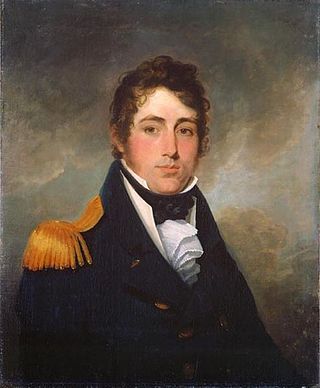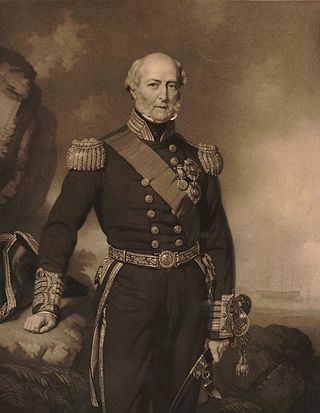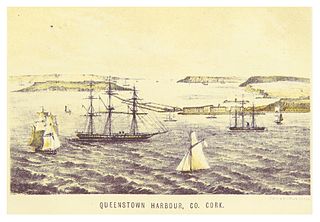Arthur Forbes | |
|---|---|
| Died | 20 March 1891 |
| Allegiance | |
| Service/ | |
| Rank | Admiral |
| Commands held | HMS Calypso HMS Curacoa HMS Renown Queenstown |
Admiral Arthur Forbes (died 20 March 1891) was a Royal Navy officer who became Commander-in-Chief, Queenstown.
Arthur Forbes | |
|---|---|
| Died | 20 March 1891 |
| Allegiance | |
| Service/ | |
| Rank | Admiral |
| Commands held | HMS Calypso HMS Curacoa HMS Renown Queenstown |
Admiral Arthur Forbes (died 20 March 1891) was a Royal Navy officer who became Commander-in-Chief, Queenstown.
Forbes became commanding officer of the sixth-rate HMS Calypso in July 1851, commanding officer of the frigate HMS Curacoa in May 1857 and commanding officer of the second-rate HMS Renown in November 1857. [1] His last appointment was as Commander-in-Chief, Queenstown in November 1869 before he retired in May 1871. [2]

Admiral of the Fleet Sir Provo William Parry Wallis, was a Royal Navy officer. As a junior officer, following the capture of USS Chesapeake by the frigate HMS Shannon during the War of 1812, the wounding of HMS Shannon's captain and the death of her first lieutenant in the action, he served as the temporary captain of HMS Shannon as she returned to Halifax, Nova Scotia, with Chesapeake.
Admiral of the Fleet Sir Nowell Salmon, was a Royal Navy officer. As a junior officer he served in the naval brigade and took part in the Siege of Lucknow during the Indian Mutiny. He was a member of the force defending the Residency when he volunteered to climb a tree near the wall of the Shah Nujeff mosque to observe the fall of shot, despite being under fire himself and wounded in the thigh. He and his colleague, Leading Seaman John Harrison, were awarded the Victoria Cross, the highest award for gallantry in the face of the enemy that can be awarded to British and Commonwealth forces for this action.

Admiral of the Fleet Sir John Edmund Commerell, was a Royal Navy officer. As a junior officer, he was present at the Battle of Vuelta de Obligado in November 1845 during the Uruguayan Civil War. He also took part in operations in Sea of Azov during the Crimean War and went ashore with the quartermaster and a seaman, to destroy large quantities of enemy forage on the shore. After a difficult and dangerous journey they reached their objective – a magazine of corn – and managed to ignite the stacks, but the guards were alerted and immediately opened fire and gave chase. The men had difficulty in escaping, but they finally reached their ship and the lookouts later reported that the forage store had burned to the ground. He and his colleague, Quartermaster William Thomas Rickard, were awarded the Victoria Cross, the highest award for gallantry in the face of the enemy that can be awarded to British and Commonwealth forces.

Admiral of the Fleet Sir James Hope, GCB was a Royal Navy officer. As a captain he was present at the Battle of Vuelta de Obligado during the Uruguayan Civil War and then in the Baltic Sea during the Crimean War.
Admiral of the Fleet Sir William Bowles, KCB was a senior Royal Navy officer and Conservative Party politician. After serving as a junior officer in the French Revolutionary Wars, he became commanding officer of the sloop HMS Zebra and took part in the bombardment of Copenhagen in September 1807 during the Napoleonic Wars. As commanding officer of the fifth-rate HMS Medusa, he took part in operations off the north coast of Spain and led a naval brigade in a raid on Santoña.

Admiral of the Fleet Sir George Francis Seymour, was a Royal Navy officer. After serving as a junior officer during the French Revolutionary Wars, Seymour commanded the third-rate HMS Northumberland under Admiral Sir John Duckworth at the Battle of San Domingo during the Napoleonic Wars. He also commanded the sloop HMS Kingfisher at the blockade of Rochefort and the fifth-rate HMS Pallas under Admiral Lord Gambier at the Battle of the Basque Roads. He then saw active service during the War of 1812.
Admiral of the Fleet Sir Charles Morton Forbes, was a Royal Navy officer. He served in the First World War, seeing action in the Dardanelles campaign and at the Battle of Jutland and, as captain of a cruiser, was present at the surrender of the German fleet. During the Second World War, he served as Commander-in-Chief, Home Fleet: his fleet suffered heavy losses including the aircraft carrier HMS Glorious and nine destroyers during the Norwegian campaign in Spring 1940. He went on to be Commander-in-Chief, Plymouth in May 1941 and in that capacity he organised the defence of Plymouth from air attack, prosecuted attacks on enemy shipping using the harbour at Brest as well as other ports along the French coast, and also initiated the St Nazaire Raid in March 1942 before retiring in August 1943.

Admiral of the Fleet Thomas Maitland, 11th Earl of Lauderdale, was a Royal Navy officer and peer. As a junior officer he saw action supporting the blockade of Algiers by Greek revolutionaries in July 1824 during the Greek War of Independence and then took part in an operation to land a naval brigade in Brazil to protect Pedro I, the Emperor of Brazil, in the face of the Irish and German Mercenary Soldiers' Revolt. He also took part in the Battle of Luchana, an operation to defend the Port of Bilbao on the north coast of Spain, during the First Carlist War.

Admiral of the Fleet Sir Houston Stewart, was a Royal Navy officer and briefly a Liberal Party Member of Parliament. After serving as a junior officer in the Napoleonic Wars, Stewart became commanding officer of the third-rate HMS Benbow in the Mediterranean Fleet and took part in the bombardment of Acre during the Egyptian–Ottoman War. He went on to be Captain-Superintendent of Woolwich Dockyard and then Controller-General of the Coastguard.

Admiral of the Fleet Sir Arthur Dalrymple Fanshawe, was a Royal Navy officer. As a captain he became commanding officer, successively, of the troopships HMS Jumna and HMS Malabar, which were tasked with ferrying troops between the United Kingdom and India. These were difficult commands with regular disputes between the military officers in charge of the troops and the naval officers in command of the ships.
Admiral of the Fleet Sir (George) Rodney Mundy, was a Royal Navy officer. As a commander, he persuaded the Dutch to surrender Antwerp during the Belgian Revolution and then acted as a mediator during negotiations between the Dutch and the Belgians to end hostilities. As a captain, he was deployed to the East Indies Station and was asked to keep the Sultan of Brunei in line until the British Government made a final decision on whether to take the island of Labuan: he took the Sultan's son-in-law, Pengiran Mumin, to witness the island's accession to the British Crown in December 1846. He was then deployed to the seas of Finland, where he secured Björkö Sound in operations against Russia during the Crimean War.
Admiral of the Fleet Sir Charles Gilbert John Brydone Elliot was a Royal Navy officer. As a junior officer he was involved in the bombardment of Acre during the Egyptian–Ottoman War.

Admiral of the Fleet Sir Henry John Codrington KCB was a Royal Navy officer. As a junior officer, he saw action during the Greek War of Independence and was present at the Battle of Navarino. He later undertook a survey of enemy positions prior to the bombardment of Acre during the Egyptian–Ottoman War.
Admiral Sir Claude Henry Mason Buckle was an English naval officer.

The Commander-in-Chief, Coast of Ireland was both an admiral's post and a naval formation of the Royal Navy. It was based at Queenstown, now Cobh, in Ireland from 1793 to 1919. The admiral's headquarters was at Admiralty House, Cobh.

Admiral Edmund Frederick Jeffreys CVO was a Royal Navy officer who became Senior Officer, Coast of Ireland Station.
Admiral Edmund Heathcote was a Royal Navy officer who became Commander-in-Chief, Queenstown.
Admiral Sir Lewis Tobias Jones was a Royal Navy officer who became Commander-in-Chief, Queenstown.
Admiral Manley Hall Dixon was a Royal Navy officer who became Commander-in-Chief, Queenstown.
Vice Admiral Donald Hugh Mackay was a Royal Navy officer who became Commander-in-Chief, Queenstown.